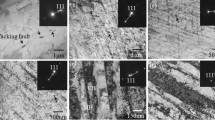Abstract
The evolution of dislocation density in iron deformed at 173 K and at room temperature has been examined by transmission electron microscopy (TEM). At room temperature, the dislocation density in the cell walls increases as the deformation progresses up to large strains, whereas in cell interiors, the density evolves toward a saturation value. A linear relationship exists between the flow stress and the square root of total dislocation density both at 173 K and room temperature. The dependence of deformation behavior on the evolution of dislocation structures is discussed in terms of a model considering the dislocation distribution during deformation. Comparison of the calculated result using this model with the experimental curve at room temperature gives excellent agreement. The changes of deformation behaviors at different temperatures can be described by the effect of temperature on the evolution of dislocation distribution.
Similar content being viewed by others
References
Y. Lan, H.J. Klaar, and W. Dahl:Metall. Trans. A., 1992, vol. 23A, pp. 537–44.
Y. Lan, H.J. Klaar, and W. Dahl:Scripta Metall., 1990, vol. 24, pp. 337–42.
U.F. Kocks:J. Eng. Mater. Technol. (ASME), 1976, vol. 98, pp. 76–85.
U.F. Kocks and H. Mecking: inStrength of Metals and Alloys, P. Haasen, V. Gerold, and G. Kostorz, eds., Pergamon Press, Oxford, United Kingdom, 1979, vol. 1, pp. 345–50.
H. Mecking and U.F. Kocks:Acta Metall., 1981, vol. 29, pp. 1865–75.
H. Mecking: inDislocation Modelling of Physical Systems, M.F. Ashby, R. Bullough, C.S. Hartley, and J.P. Hirth, eds., Pergamon Press, Oxford, United Kingdom, 1981, pp. 197–211.
F.B. Prinz and A.S. Argon:Acta Metall., 1984, vol. 32, pp. 1021–28.
W.D. Nix, J.C. Gibeling, and D.A. Hughes:Metall. Trans. A, 1985, vol. 16A, pp. 2215–26.
D. Kuhlmann-Wilsdorf: inWork Hardening, J.P. Hirth and J. Weertman, eds., Gordon and Breach, New York, NY 1968, pp. 97–139.
J.E. Bailey and P.B. Hirsth:Phil. Mag., 1960, vol. 5, pp. 485–97.
P. Haasen: inStrength of Metals and Alloys, Proc. ICSMA-8, P.O. Kettunen, T.K. Lepistö, and M.E. Lehtonen, eds., Pergamon Press, New York, NY, 1988, pp. 343–48.
A.H. Cottrell:Dislocations and Plastic Flow in Crystals, Clarendon Press, Oxford, United Kingdom, 1953.
J.W. Hutchinson:J. Mech. Phys. Solids, 1964, vol. 12, pp. 25–33.
G. Langford and M. Cohen:Trans. ASM, 1969, vol. 62, pp. 623–38.
George Langford and Morris Cohen:Metall. Trans. A, 1975, vol. 6A, pp. 901–10.
A.S. Keh and S. Weissmann: inElectron Microscopy and Strength of Crystals, G. Thomas and J. Washburn, eds., Interscience, New York, NY, 1963, pp. 231–300.
D.J. Dingley and D. McLean:Acta Metall., 1967, vol. 15, pp. 885–901.
J.P. Bailon, A. Loyer, and J.M. Dorlot:Mater. Sci. Eng., 1971, vol. 8, pp. 288–98.
W. Roberts, S. Karlsson, and Y. Bergström:Mater. Sci. Eng., 1973, vol. 11, pp. 247–54.
M. Döner, H. Chang, and H. Conrad:Metall. Trans. A, 1975, vol. 6A, pp. 1017–28.
J. Gil Sevillano, P. van Houtte, and E. Aeronoudt: inProgress in Materials Science, J.W. Christian, P. Haasen, and T.B. Massalski, eds., Pergamon Press, New York, NY, 1981, vol. 25, pp. 69–412.
A.D. Rollett, U.F. Kocks, J.D. Embury, M.G. Stout, and R.D. Doherty:Strength of Metals and Alloys, Proc. ICSMA-8, P.O. Kettunen, T.K. Lepistö, and M.E. Lehtonen, eds., Pergamon Press, New York, NY, 1988, pp. 433–38.
Author information
Authors and Affiliations
Rights and permissions
About this article
Cite this article
Lan, Y., Klaar, H.J. & Dahl, W. Evolution of dislocation structures and deformation behavior of iron at different temperatures: Part II. dislocation density and theoretical analysis. Metall Trans A 23, 545–549 (1992). https://doi.org/10.1007/BF02801172
Received:
Issue Date:
DOI: https://doi.org/10.1007/BF02801172



